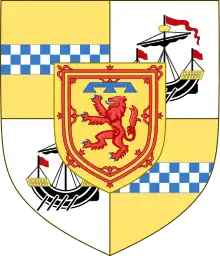Lord High Steward of Scotland
The title of High Steward or Great Steward is that of an officer who controls the domestic affairs of a royal household. In the 12th century King David I of Scotland gave the title to Walter fitz Alan, a nobleman from Brittany, whose descendants adopted the surname "Steward", later "Stewart" and later founded the royal House of Stewart.[1] A junior branch of the Stewart family descended from the younger son of Alexander Stewart, 4th High Steward of Scotland (d.1283), namely "Stewart of Darnley", paternal ancestors of King James I & VI, lived for several generations in France, when the name became spelt in the French manner "Stuart" and "Dernelé".[2] In 1371 Robert Stewart, 7th High Steward of Scotland inherited the throne of Scotland via his mother and became King Robert II of Scotland, when the title or office of High Steward of Scotland merged into the crown. However it was re-granted by the monarch to his elder son and heir apparent, together with the titles Duke of Rothesay (created 1398) and Baron of Renfrew (created 1404). Thus, currently, The Prince of Wales is High Steward of Scotland, sometimes known as the Prince and Great Steward of Scotland.[3][4]


The Prince of Wales had the idea of incorporating his Scottish titles - Duke of Rothesay, Lord of the Isles and Great Steward of Scotland - into a banner. It was designed in 1974 by Sir Iain Moncrieffe in his capacity as Albany Herald and approved by The Queen later that year. The standard, exclusively for use when The Prince is in Scotland, was first flown on 21st July 1976, when he visited Loch Kishorn, Wester Ross, to launch the Ninian Central oil platform production dock, the site of which was part of the ancient lordship of the Isles. The standard is also known as "His Royal Highness's Scottish Banner" (official web-site of the Prince of Wales)
High Stewards of Scotland, c. 1150–present
- Walter Fitz-Alan, 1st High Steward of Scotland c. 1150–1177
- Alan Fitzwalter, 2nd High Steward of Scotland 1177–1204
- Walter Stewart, 3rd High Steward of Scotland 1204–1246
- Alexander Stewart, 4th High Steward of Scotland 1246–1283
- James Stewart, 5th High Steward of Scotland 1283–1309
- Walter Stewart, 6th High Steward of Scotland 1309–1327
- Robert Stewart, 7th High Steward of Scotland (Robert II of Scotland) 1327–1371
- John Stewart, 8th High Steward of Scotland (Robert III of Scotland) c. 1371–1390
- David Stewart, Duke of Rothesay 1398–1402
- James Stewart, Duke of Rothesay (James I of Scotland) 1402–1406
- Alexander Stewart, Duke of Rothesay 1430
- James Stewart, Duke of Rothesay (James II of Scotland) 1430–1437
- James Stewart, Duke of Rothesay (James III of Scotland) 1453–1460
- James Stewart, Duke of Rothesay (James IV of Scotland) 1473–1488
- James Stewart, Duke of Rothesay 1507–1508
- Arthur Stewart, Duke of Rothesay 1509–1510
- James Stewart, Duke of Rothesay (James V of Scotland) 1512–1513
- James Stewart, Duke of Rothesay 1540–1541
- James Stuart, Duke of Rothesay (James VI & I) 1566–1567
- Henry Frederick Stuart, Duke of Rothesay (Prince of Wales) 1594–1612
- Charles Stuart, Duke of Rothesay (Charles I) 1612–1625
- Charles Stuart, Duke of Rothesay (Charles II) 1630–1649
- James Francis Edward Stuart, Duke of Rothesay 1688–1689
- George Augustus, Duke of Rothesay (George II) 1714–1727
- Frederick Louis, Duke of Rothesay (Prince of Wales) 1727–1751
- George, Duke of Rothesay (George IV) 1762–1820
- Albert Edward, Duke of Rothesay (Edward VII) 1841–1901
- George, Duke of Rothesay (George V) 1901–1910
- Edward, Duke of Rothesay (Edward VIII) 1910–1936
- Charles, Duke of Rothesay (Prince of Wales) 1952–
References
- Scott, Walter (1830). The History of Scotland. Carey & Lea. p. 219. Retrieved 2 December 2018.
title of High Steward.
- Cust, Lady Elizabeth, Some Account of the Stuarts of Aubigny, in France, London, 1891
- Hanks, Patrick; Coates, Richard; McClure, Peter (2016). The Oxford Dictionary of Family Names in Britain and Ireland. Oxford University Press. p. 2550. ISBN 9780192527479. Retrieved 2 December 2018.
- Ertl, Alan W. (2013). Scotland's Road to Independence: The Makings of a State Identity. Universal-Publishers. p. 138. ISBN 9781612332864. Retrieved 2 December 2018.